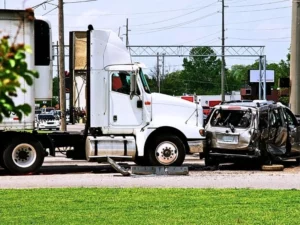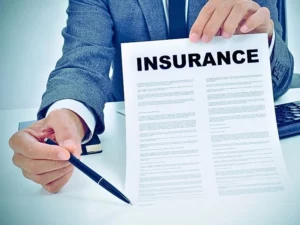If someone gets into an accident while driving your vehicle in Chicago, your insurance or the insurer of another liable party may be able to cover the damages resulting from the accident. However, certain factors will influence the outcome of these types of cases and determine who pays for the damages.

What Happens if Someone Gets in an Accident While Driving Your Car?
After a crash, you might ask, “What happens if someone else is driving my car and gets in an accident?” Generally, the answer to this is that you will need to file an insurance claim with your own insurance company if this occurs.
You might also ask, “Do you insure the car or the driver in an accident?” Insurance companies follow the car and not the driver, contrary to popular myth. As a result, your insurance company will likely be able to cover most of the costs associated with an accident when someone else drives your vehicle with your permission. Insurance policies often cover property damage, injuries, and other related costs.
In some cases, however, you may be able to file an insurance claim against another party, such as another driver, who is liable for the accident. The at-fault party’s insurance would then begin negotiating a settlement.
Permissive vs. Non-Permissive Use
One factor that can influence which insurance company pays for the damages resulting from an accident is whether the driver of your vehicle has permissive or non-permissive use at the time of the accident.
Here is a breakdown of the differences between these types of use to help figure out how to determine liability:
Permissive Use
Your auto insurance policy likely covers any drivers named in the policy, along with people you give explicit permission to operate your vehicle. If another driver has permissive use of your vehicle, this would mean that your insurance company would still cover the costs resulting from an accident involving your vehicle.
Non-Permissive Use
While your insurance may need to cover the cost of an accident involving a driver who has permissive use of your vehicle, the driver may need to cover damages if he or she didn’t have permission to operate your vehicle at the time of the accident.
Different parties could have non-permissive use of your vehicle and operate your vehicle without your consent. For example, a member of your household or a friend could decide to borrow your vehicle without letting you know, making the driver liable for any damages he or she causes in a car accident.
If the driver without permissive use has a policy with an insurance company, that policy will likely cover the damages. However, if the driver doesn’t have insurance or has insufficient insurance, the vehicle owner may still need to file a claim with his or her own insurance company to cover the damages.
Even if someone you don’t know steals your vehicle and causes an accident, your insurance policy may need to cover repairs to the vehicle, although you wouldn’t likely need to cover damages that the other party sustained in the accident.
Know How Your Car Insurance Covers Other Drivers
The best way to determine who would be liable for paying for the damages in an accident involving your vehicle is to review your insurance policy. Take a look at the finer details and find out whether the insurance company will cover damages if someone else operates your vehicle with or without permissive use.
Looking at your policy can also answer other questions you may have, such as “will my car insurance cover me in another car?” You can also find out whether you have partial or full coverage under your policy.
What if the Driver Has His or Her Own Insurance Policy?
As mentioned, if someone else drives your vehicle without your consent, the driver’s insurance would normally be able to help cover the costs of an accident if he or she is liable. However, this isn’t going to be the case if the driver doesn’t have adequate insurance coverage.
If the driver has an auto insurance policy, he or she would file a claim with his or her insurer to begin the claims process. Conversely, if the driver doesn’t have coverage, you would be responsible for filing a claim with your own insurance to cover the costs.
Of course, if another party is liable for the accident and the driver of your vehicle is the victim, it would be possible to file a third-party liability claim against the liable party’s insurance company.
What Should You Do After Someone Else Crashes Your Car?
If someone else gets into an accident while driving your vehicle, you must take certain steps to resolve the issue and potentially recover damages resulting from the accident through your own insurance, the driver’s insurance, or another liable party’s insurance.
The following are the specific steps to take in these situations:
1. Take a Look at Your Insurance Policy
To determine how your coverage works and what it covers, review the terms and conditions of your auto insurance policy. Doing so will help you figure out whether your coverage is sufficient to pay out damages resulting from an accident, including everything from property damage to bodily injury.
Your policy could also include different types of add-ons that enhance your coverage, such as collision and rental car coverage.
2. Consult With a Chicago Car Accident Attorney
Another crucial step to take following any car accident involving extensive damages and complex liability is to consult with a car accident lawyer.
An experienced lawyer who has handled these types of cases may be able to give you some guidance. For instance, he or she may be able to help determine who was liable for the accident and subsequent damages. The attorney may then be able to identify and calculate all damages and work with you to recover compensation.
One of the key benefits of working with an attorney is the ability to negotiate settlements more effectively with insurance companies. Insurers often work to reduce or deny claims, but your attorney work to recover total compensation and make counteroffers whenever insurers make offers that fall below the actual settlement value.
If your case winds up going to trial, a car accident attorney with trial experience can help you take your case to court.
3. Gather Sufficient Evidence
To build a successful case against liable parties after a car accident, it’s important to collect as much evidence as possible to support your case.
There are many pieces of evidence you can use in these cases. Some examples include:
- Medical records, bills, and receipts
- Police reports filed immediately after the accident
- Photos and video footage of the accident scene, injuries, and property damage
- Proof of lost income
- Witness statements
If you have trouble obtaining any of this evidence, this is where your lawyer may also help. An experienced attorney can get in touch with medical professionals, police, witnesses, and even others like expert witnesses who may be able to help support your case.
4. Begin the Claims Process
Once you’ve met with an attorney, reviewed your insurance policy, and gathered evidence to help support your claim, you can begin filing a claim against the liable party.
If you’re filing a third-party liability claim, you will need to get in touch with the liable party’s insurer. The insurance company will then assign an adjuster to your case to determine liability and negotiate a settlement.
If you have an attorney by your side during this process, he or she may help organize and present evidence in your favor and fight for total compensation. While the insurer may make an initial lowball offer, your attorney can continue negotiations with counteroffers.
Although most cases settle during the claims process, the case may go to trial, in which case your attorney can represent you during legal proceedings.
Look into Your Policy and Determine Liability to Begin a Claim
With a better understanding of what happens when someone gets into an accident while driving your vehicle, you can determine how a potential accident case might proceed. Be sure to understand your insurance policy and the specific types of coverage you have, and determine your next steps based on whether the driver of your vehicle had permissive or non-permissive use of your vehicle.Taking the right steps after this type of accident can help you successfully navigate the claims process and potentially seek full compensation from liable parties involved in the accident.







